In Which It Begins And Ends With The Fish
 Tuesday, August 5, 2008 at 2:18PM
Tuesday, August 5, 2008 at 2:18PM 
Tsukiji
by Brian DeLeeuw
The tuna auctions at Tokyo’s Tsukiji fish market start around 5:30AM, but the market’s already been active for hours. The bluefin carcasses are displayed on raised pallets, six or seven to a pallet, about thirty pallets lined up across the frigid hall’s concrete floor. And these are inarguably carcasses, dead animals not yet refigured as food, their bellies slit, their tails chopped off and stuffed into their open mouths. Licensed buyers stroll through the rows in the hour before the auction starts, prying open the bellies with long-shafted hooks and peering inside with industrial flashlights. An especially thorough buyer swabs at a severed tail with his forefinger and samples the goods, chewing thoughtfully, and then, just as at the NYSE or any other heavyweight site of exchange, the opening bell rings and it begins.
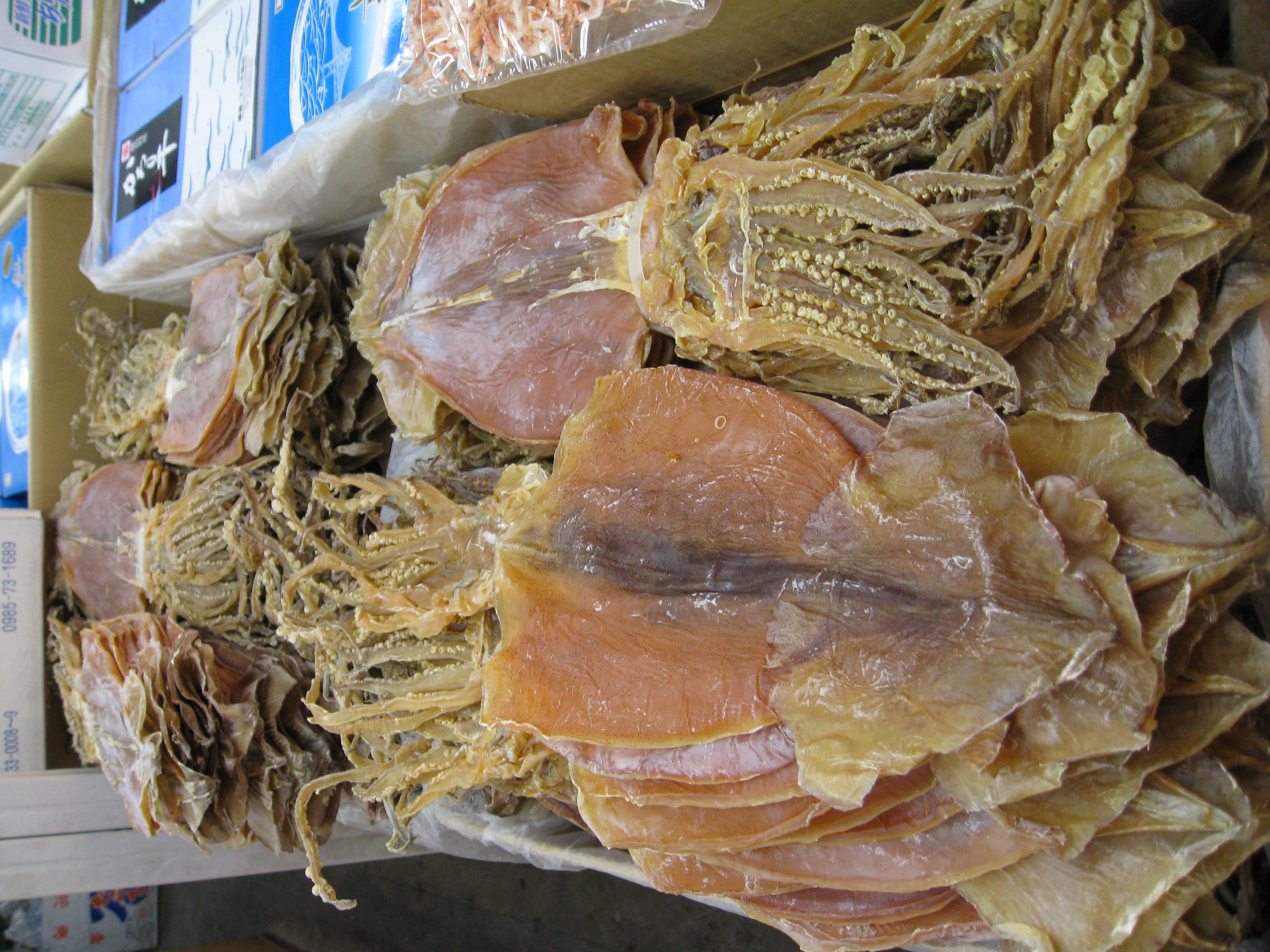
Auctioneers lead their customers from fish to fish, business conducted through rapid-fire yelling and coded hand-signals, the buyer’s ID slapped up on each tuna’s flank with blood-red ink.
Workers cart purchases out to the labyrinthine city of stalls sprawling beyond the auction hall, where – amongst sea slugs, tiger prawns, giant scallops, fugu (blowfish), and hundreds of other species – they will be dismantled with three-foot long magurobocho knives or, for the frozen torsos, massive band saws.
The tuna have arrived from as close as Hokkaido and as far as Boston; they could be headed to a sushi bar on the other side of the parking lot or back across two oceans to New York City. Over fifty tons of tuna have changed hands. The whole process takes less than half an hour.
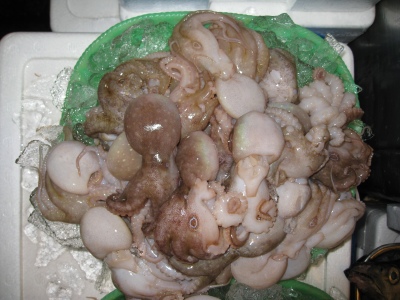
There is no one way of looking at Tsukiji; even familiar binaries – tradition vs. modernization, overt chaos vs. hidden order, the local vs. the global, the grotesque vs. the beautiful – oversimplify despite their modicum of truth.
Also a simplification, but one I will stand by, is that Tsukiji is a triumph of the visceral and the immediate over the denatured and the vague. Its panoply of sea creatures – circling in fish tanks, flopping in sawdust, or diced and filleted on steel platters – annihilate our often abstracted relationship to what we eat.
The original meaning of the word “market” – an actual physical place for the exchange of goods, rather than a vast and nebulous system of pricing – declares itself in every puddle of brine, every mouthful of diesel fuel and secondhand smoke.
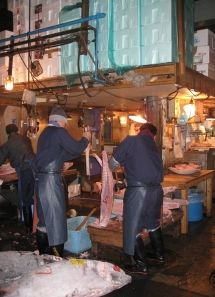
But before we go any further, the facts. (All statistics taken from Theodore C. Bestor’s excellent Tsukiji: The Fish Market at the Center of the World (University of California Press, 2004).) About $19.4 million worth of seafood is traded here every day, adding up to a yearly total that’s usually around $5 billion.
Each working day sees well over two million kilograms (almost five million pounds) of goods change hands – that’s roughly 600 kilograms per year. This is more than seven times the volume and five times the value of trade at New York’s Fulton Fish Market, the world’s second largest seafood market. (At least in the one year in recent times – 1996 – that Fulton’s normally closed books were opened, due to Mob-related federal racketeering charges.)
Seven large auction houses employing approximately 700 auctioneers sell 450 “major” species and varieties of seafood – over 2,000 if you count sub-varieties – to about 900 licensed wholesalers and 375 authorized traders.
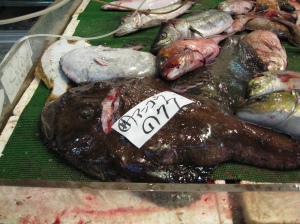
The traders buy in bulk for outside customers like restaurant chains and supermarkets, while the wholesalers operate 1,667 stalls lined up cheek-to-jowl along narrow, manically-trafficked alleys, selling on the spot to sushi chefs, restaurateurs, fishmongers, and assorted other regulars.
The market occupies over two-million square feet of mostly landfill (Tsukiji literally means “built land”) on the banks of the Sumida River in central Tokyo. About 50,000 people come to the market six mornings a week, and nobody there cares if you are number 50,001.
The basic indifference to your presence as an interloper feels both polite and remarkable. The obvious reason is that people are too busy to be either solicitous or hostile; there is much to do and very little time in which to do it. I was only spoken to when a workman accidentally knocked a twenty-foot tower of thankfully empty Styrofoam containers onto my head.
He gave a brief bark of a laugh, then said something probably along the lines of “That’s not a good place to stand.” But there is no good place to stand because everywhere, no matter how narrow the passageway or remote the corner, is fair game for the “turrets,” three-wheeled motorized carts with a vertical, cylindrical steering column (hence the name) at which drivers stand, squinting through cigarette smoke as they execute NASCAR-caliber maneuvers in the clotted cobblestone alleys.

The clearances between carts and stalls, carts and pedestrians, and, especially, carts and other carts are rarely more than a few inches. The visitor’s primary responsibility is to eschew unpredictable swerves and pauses; travel straight lines or just stand stock-still as the turrets zip pass, and you’ll be fine.
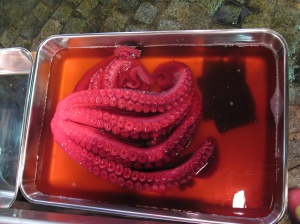
What you’ll survive to see among Tsukiji’s 1,667 stalls is the mind of an ichthyologist (or malacologist – look it up, I had to) turned inside out, flaunting its wild knowledge to the world. Clutches of boiled octopi float in bins like red, angry brains in formaldehyde. Dried squids are stacked like dirty laundry. Sardines shimmer in tightly-packed cartons, and lobsters squirm around in sawdust like toddlers in a sandpit. At one of the countless eel stalls, a wholesaler slaps each writhing specimen onto the cutting board, impales it through the eye with a hook, and deposits it into a bin to rest with its brethren in a soup of their own blood.
But the most impressive sight must be the slicing up of the bluefin tuna fresh from auction. The wholesalers wielding their magurobocho – knives in name only, these look more like samurai swords – are highly trained, and how could they not be? One false cut could ruin the fish, and this is expensive shit, sometimes reaching up to $52 per pound for a particularly excellent bluefin. The knives glide through the thick flesh as though it were tofu, and in a few strokes dead fish are transformed into slabs and strips of ruby-red food, priced and displayed under glass like precious jewels.
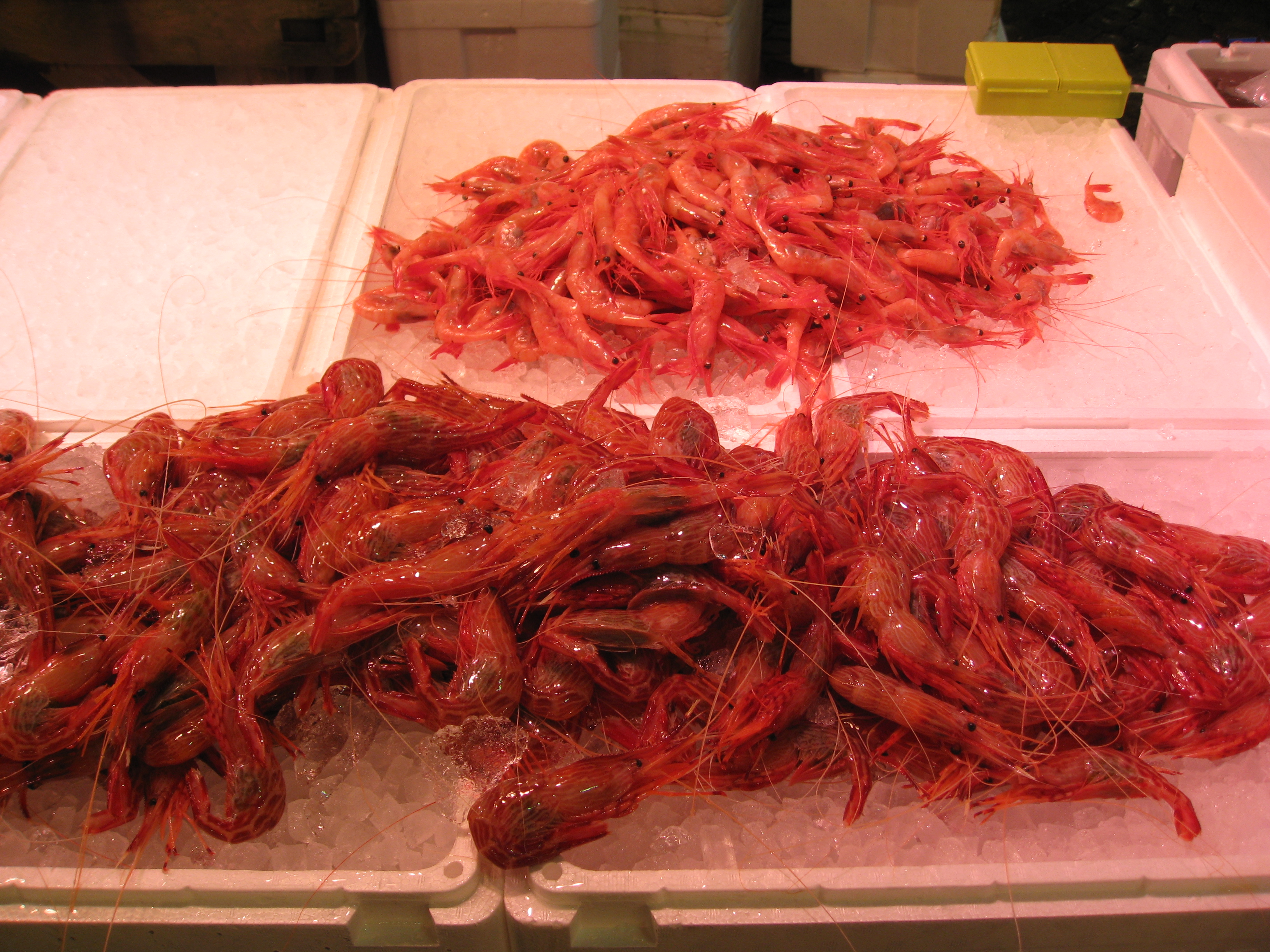
It’s a brutal scene, but the careful ritual of this transformation from animal to food complicates any ethically-minded vegetarian crusade, a cause for which the mantras of disrespect for animals and environmental degradation are often invoked. It is easy to say we are behaving callously, perhaps even immorally, towards chickens forced to live out their short lives in cramped cages full of their own shit or dolphins drowned for having the nerve to get caught up in albacore tuna nets.
(Although any Japanese whaler would argue that the moral difference between the West’s aggressively anthropomorphic dolphin and our dull lump of a tuna is largely a culturally constructed one.)

It is less easy to accuse a free-range pig farmer or a devoted elk hunter of animal abuse or ignorance, and it is less easy still to direct these charges at Tsukiji’s tuna wholesalers, who describe the very act of cutting the flesh as maguro no kaiwa (“the conversation of the tuna”), or at the auction buyers, who can assess a bluefin’s health and much of its history with a few glances and gentle palpations.
In short, no one loves fish more than a fisherman. One reason for this is the daily intimacy that leads, in most cases, not to contempt but to appreciation. Another reason, of course, is that everyone in the business depends upon the continuing sustainability of seafood for their livelihoods, which is the impetus for a kind of pragmatic environmentalism.
Two years ago, while doing research for a magazine article, I interviewed the head chefs of a few of Manhattan’s priciest seafood-centric restaurants. (No one fetishizes fish more than a French chef.) The ostensible purpose of the interviews was to identify the factors that produce the “trendy” fish of a given moment – the Chilean sea bass of the 90s or the miso-glazed black cod of the early 2000s – but all they wanted to talk about was preservation and responsible fishing. Most thought mandated fishing bans were often too little, too late, and instead they opted to self-police.
As one put it, we can have unlimited red snapper now and none at all very soon, or we can fish it responsibly now and eat it sparingly forever.
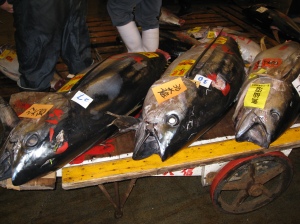
To argue that all fishermen or restaurateurs are as committed to the long-term good would be naïve, but here at Tsukiji a recognition of at least the karmic cost of fishing is evident in the six stone monuments at the Nami-yoke Shrine, just outside the marketplace’s Kaiko Bridge entrance. These monuments honor the sacrifice of fish in the service of human cuisine. (Well, five do; the last is for the eggs that are also used in some sushi preparations).
As Bestor writes of the memorials in his authoritative study of the market: “People in the seafood trade know full well that fish die so that humans may eat, and Japanese Buddhism and folk belief not only posit a consequence of this (that the innocent dead may harm the living) but also provide a means to atone and avoid retribution.”
It’s doubtful that a carved slab of stone and a pragmatic – some would say selfish – interest in seafood sustainability is enough for the hard-line vegetarian or environmentalist. But such gestures at least indicate an awareness of the source and, for lack of a less squishy term, spirit of our food, something citizens of the post-industrial world often lack.
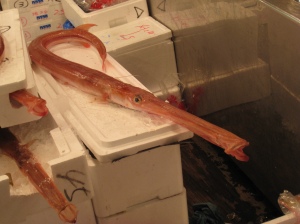
I, however, am not one of those hard-line vegetarians, and so it would have been madness to have left Tsukiji without sampling the product of all this complicated interplay between cultural traditions, economic imperatives, and environmental concerns.
In other words, I wanted to eat sushi for breakfast. This wasn’t a problem: a narrow street on the far side of an endless, buzzing parking lot houses at least half a dozen tiny sushi bars, all already packed and some with two-hour waits at 7:30 a.m.
It was also Saturday, which meant that many of the patrons were young and either still drunk or newly hungover, here direct from the glitzy nightspots of the neighboring Ginza district. The bitter February cold quickly drove me and my girlfriend into one of the less trafficked establishments offering only a fifteen minute wait for seats at the ten-person bar.
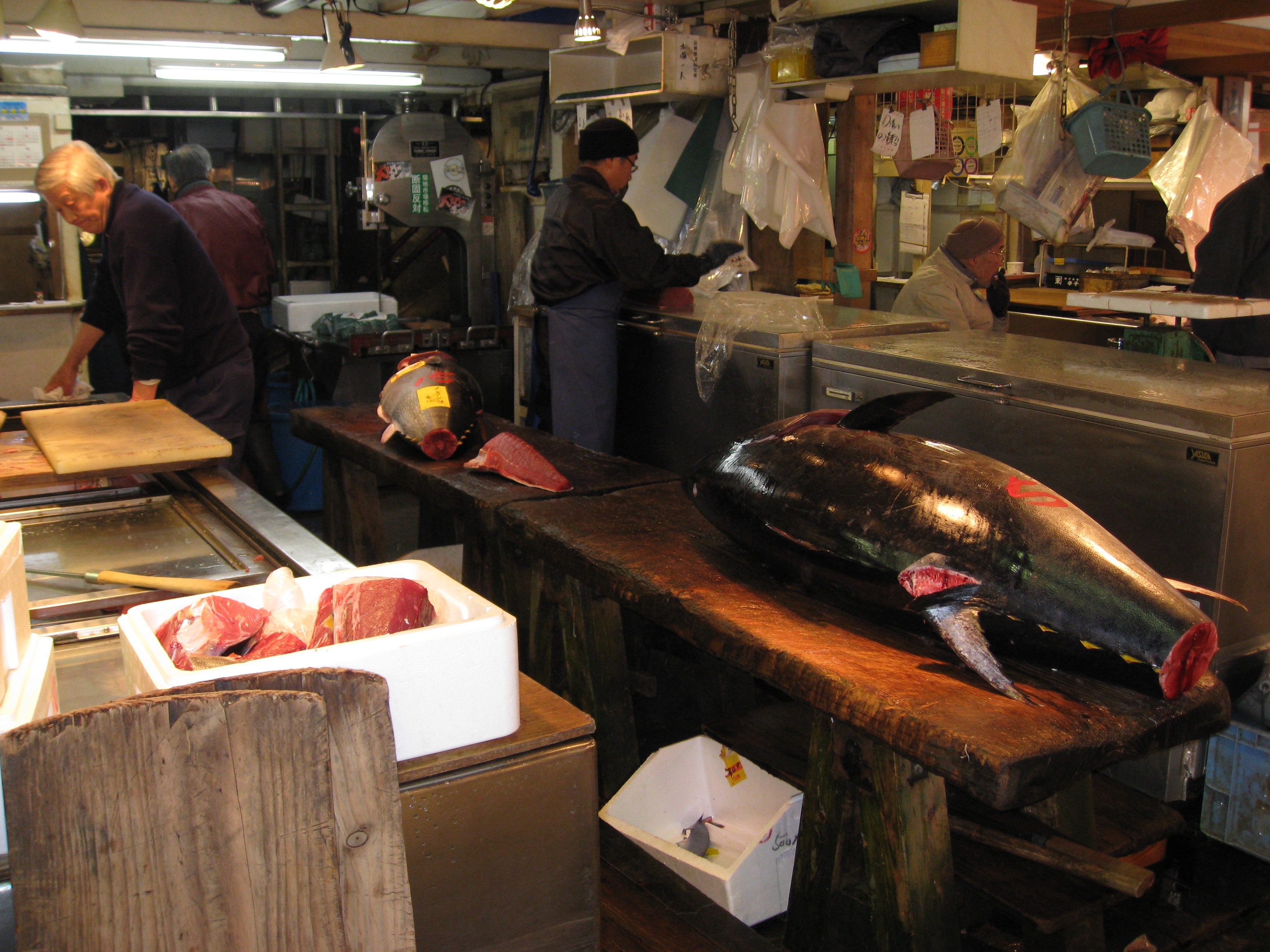
Freezing and shipping technologies have discredited the seafood maxim that freshness requires proximity to the catch, as the globalized selection at Tsukiji itself demonstrates. However, doing your daily sushi business in the market’s shadow does ensure quality connections, as well as the necessity of pleasing a demanding clientele.
Our breakfast proved it: the omakase of toro (tuna belly), tuna, salmon, octopus, squid, tamago (sweet egg omelet), sweet shrimp, “normal” shrimp, salmon roe, scallop, mackerel, and an unidentifiable white fish that sounded like hake but wasn’t, all washed down with miso soup and green tea, was truly excellent and, at ¥2,800, less than half of what it would cost in New York.
Authenticity is a concept almost always invoked by an outsider, an inauthentic person. So for me to expound upon the virtues of eating sushi at the world’s biggest fish market surrounded by happy drunks, sushi snobs, and Korean tourists, with those crazy turret carts whizzing by and the early-morning sun shining through the window, and to frame the event as some sort of authentic echt-Japanese experience: this would be naïve, probably a bit patronizing, and definitely the sentiments of a typical golly-gee gaijin. Well, fuck it. The market was singular and astonishing. The sushi breakfast was delicious. I loved every minute of that morning, and, like any good tourist, I have the digital photos to prove it.
Brian DeLeeuw is the senior contributor to This Recording. You can find his previous work here, here, here, here, and here. He writes frequently on travel and food for CITY magazine. His writing has also appeared in New York, Tin House, and New York Press. His novel In This Way I Was Saved is forthcoming from Simon & Schuster in the spring of next year.
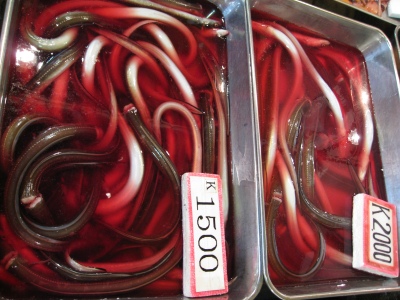
All original photography by Brian DeLeeuw and Alex Cooley.
YOUR FISH MARKET SOUNDTRACK
"Mer Du Japon (Teenagers remix)" - Air (mp3)
"Fisherman" - The Congos (mp3)
"Girl and the Sea (Cut Copy remix)" - The Presets (mp3)
"Girl and the Sea" - The Presets (mp3)
"Please" - Ikonika (mp3)
"Life's a Beach! (Todd Terje remix)" - Studio (mp3)

PREVIOUSLY ON THIS RECORDING
We're in business. It's a business.
Keith Gessen and Tyler Coates.
The glory of Jayne Mansfield.































Reader Comments (1)
[...] Brian DeLeeuw is the senior contributor to This Recording. You can find his previous work here, here, here, and here. He writes frequently on travel and food for CITY magazine. His writing has also appeared in New York, Tin House, and New York Press. His novel In This Way I Was Saved is forthcoming from Simon & Schuster in the spring of next year. He last wrote in these pages on the Tsukiji fish market. [...]